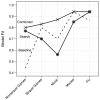Predicting consumer behavior with Web search
- PMID: 20876140
- PMCID: PMC2955127
- DOI: 10.1073/pnas.1005962107
Predicting consumer behavior with Web search
Abstract
Recent work has demonstrated that Web search volume can "predict the present," meaning that it can be used to accurately track outcomes such as unemployment levels, auto and home sales, and disease prevalence in near real time. Here we show that what consumers are searching for online can also predict their collective future behavior days or even weeks in advance. Specifically we use search query volume to forecast the opening weekend box-office revenue for feature films, first-month sales of video games, and the rank of songs on the Billboard Hot 100 chart, finding in all cases that search counts are highly predictive of future outcomes. We also find that search counts generally boost the performance of baseline models fit on other publicly available data, where the boost varies from modest to dramatic, depending on the application in question. Finally, we reexamine previous work on tracking flu trends and show that, perhaps surprisingly, the utility of search data relative to a simple autoregressive model is modest. We conclude that in the absence of other data sources, or where small improvements in predictive performance are material, search queries provide a useful guide to the near future.
Conflict of interest statement
The authors declare no conflict of interest.
Figures





References
-
- Gruhl D, Guha R, Kumar R, Novak J, Tomkins A. The predictive power of online chatter; Proceedings of the Eleventh ACM SIGKDD International Conference on Knowledge Discovery in Data Mining; New York: ACM; 2005. pp. 78–87.
-
- Asur S, Huberman B. Predicting the Future with Social Media. 2010. arXiv:1003.5699.
-
- Choi H, Varian H. Predicting initial claims for unemployment benefits. 2009. Available at http://research.google.com/archive/papers/initialclaimsUS.pdf.
-
- Choi H, Varian H. Predicting the present with Google Trends. 2009. Available at http://google.com/googleblogs/pdfs/google_predicting_the_present.pdf.
-
- Ettredge M, Gerdes J, Karuga G. Using web-based search data to predict macroeconomic statistics. Commun ACM. 2005;48:87–92.
MeSH terms
LinkOut - more resources
Full Text Sources
Other Literature Sources

